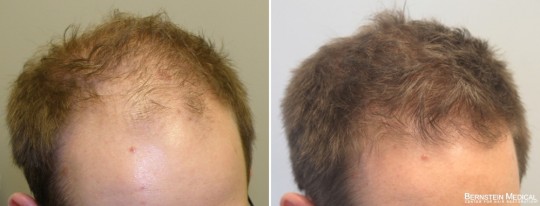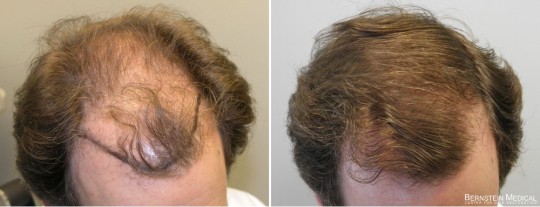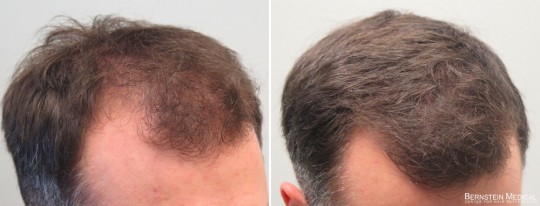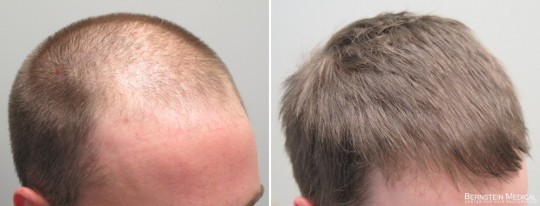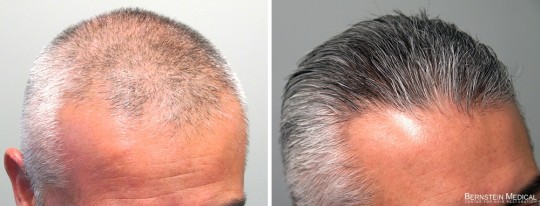Hair Loss Medications
- More about Medical Treatment for Hair Loss
- Before and After Photos of Medical Treatment
- Answers
- Video
- Research
- Consultation
Medications serve an important role in both the prevention and treatment of hair loss. They are particularly useful in the early stages of the balding process. There are two medications approved by the FDA for the treatment of common hair loss (androgenetic alopecia). These are the oral medication Propecia (which contains finasteride 1mg) and the topical medication Rogaine (that contains minoxidil).
Both of these medications reverse or slow down miniaturization, a hormone-driven process in which hair follicles shrink over time until they eventually disappear. Although both drugs are useful in treating male pattern hair loss, finasteride is far more effective than minoxidil in this regard.
Propecia (Finasteride)
Finasteride inhibits dihydrotestosterone (DHT), the hormone directly responsible for miniaturization. By inhibiting DHT, finasteride increases the length and thickness of miniaturized hair. Finasteride requires a prescription but is available in a generic 1mg dose and a less expensive generic 5mg dose. Often, patients purchase the 5mg pill and divide it into 1.25mg doses using a pill cutter. Read about Propecia (finasteride).
Rogaine (Minoxidil)
Minoxidil increases the duration of the growth (anagen) phase of the hair follicle growth cycle and can also induce a new anagen phase. This improves the quality of the hair by increasing the diameter and length of the miniaturizing hairs. Rogaine and generic minoxidil are available in a variety of over-the-counter formulations. The standard doses are the 5% solution, 5% foam (men and women), and 2% solution for women. Read about Rogaine (minoxidil).
Before and After Photos
Visit our page with before and after photos of over 125 patients using finasteride and minoxidil. None of the patients have had hair transplant surgery.
Go to the Before and After Photos page.
Use
Medical treatment works best when it is started early because once a follicle completely disappears, the medication cannot regenerate a new hair. Therefore, the early diagnosis of male pattern hair loss is important and, if medical treatment is contemplated, it should be started sooner rather than later.
Medications usually take six months to a year before you can see the results. In the first few months, they may cause shedding, so one needs to be patient in order to achieve the best outcome. Medications are also most effective when used consistently over the long-term. Stopping and starting treatment is not recommended because when you stop the effects of the medication will wear off and some of the hairs that are shed may not regrow. If you start again, you may be continuing at a lower baseline.
Propecia is significantly more effective than Rogaine in treating hair loss, but they have additive effects when used together. When both are used, over 1/3 of patients can expect visible amounts of hair regrowth. In over 90% of patients, these medications can significantly slow down further hair loss.
Effectiveness on the Front of the Scalp
Since both finasteride and minoxidil were approved by the FDA for use in the crown (the back of the scalp), there is a common misconception that the drugs only work in this area. The fact is both finasteride and minoxidil work in the front and top parts of the scalp as well. Read more about the efficacy of Propecia and Rogaine at the frontal hairline.
The crown usually has hair in the thinning phase for longer periods of time than the front part of the scalp, so there is often a longer window of time for the medications to be useful in re-growing hair in this location. This helps to explain the relatively better response to medication in the back part of the scalp (the crown) compared to the front. That said, for prevention of further hair loss, the medications are equally important in all parts of the scalp.
Medicine vs. Surgery
Medications can be used alone or as part of a hair loss treatment plan that includes hair transplantation. Medical therapy works well in conjunction with hair transplant surgery since they serve different purposes; medical treatments prevent further hair loss, whereas surgery regains lost hair. A hair transplant does not prevent the progression of the balding process like medications do, but it is the only treatment that can restore hair to a very thin or completely bald area.
Side Effects
While side effects from medications and finasteride, in particular, are rare, this is a matter of great interest to hair restoration physicians who have many patients using (and benefitting from) these medications. Since 2011, Dr. Bernstein has sat on the International Society of Hair Restoration Surgery (ISHRS) Task Force on Finasteride Adverse Events where he can monitor and impart the latest medical information to patients. This is a topic that is taken very seriously at Bernstein Medical – Center for Hair Restoration.
Low-Level Laser Therapy (LLLT)
Low-Level Laser Therapy (LLLT) is a hair loss treatment based on the principle of photo-biotherapy in which laser light stimulates cell growth. The laser light stimulates hair follicles on the scalp to produce thicker hair shafts, resulting in a fuller appearance.
As with medication, patients who seem to respond to this form of therapy have thinning hair, rather than areas of the scalp that are completely bald. LLLT appears to be most useful in patients with diffuse hair loss (the most common pattern seen in women). Read about Laser Therapy for hair loss, how it works, and the various devices that are available to consumers.
Hair Cloning
Hair cloning is a promising treatment for genetic hair loss that is being actively researched by pioneering hair restoration physicians, like Dr. Bernstein in conjunction with Columbia University’s Dr. Angela M. Christiano. In hair cloning, a person’s germinative hair follicle cells are sampled, multiplied in a laboratory (in vitro), then re-implanted into the scalp where they grow new hair follicles and, thus, new permanent hair. Hair cloning methods have the potential to yield a treatment that effectively “cures” common hair loss, however, there are no such treatments available at this time. Read about Hair Cloning methods and research.
Other Treatments
There are a variety of medications and treatments, other than finasteride and minoxidil, that are commonly used to treat hair loss. None of these are approved by the FDA for the treatment of common genetic hair loss. These include medications such as Avodart (dutasteride), Aldactone (spironolactone), oral contraceptives, and Latisse (bimatoprost). Common dietary supplements purported to treat hair loss include Viviscal and saw palmetto.
There are also a variety of products and treatments that conceal or camouflage hair loss. These include cosmetic camouflage products like Toppik and DermMatch; the cosmetic ink (tattoo) application called scalp micro-pigmentation (SMP); and hair systems and wigs.
Read about these products in our Other Treatments section.



